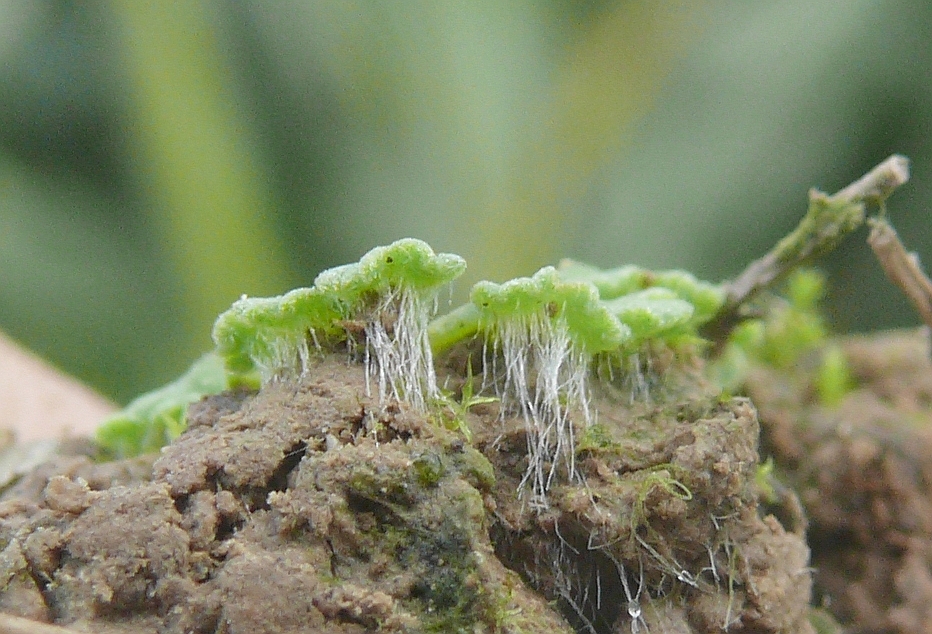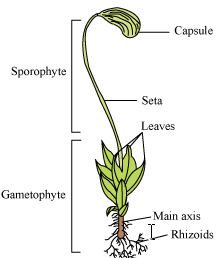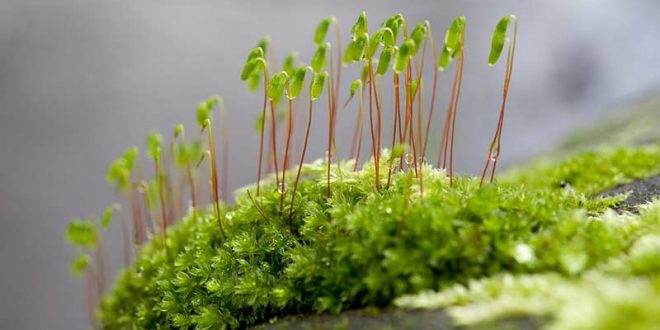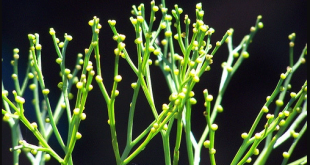Bryophyta is a division of non-flowering plants or embryophytes (land plants) characterized by rhizoids rather than true roots and having little or no organized vascular tissue and showing distinct alternation of generations: gamete bearing forms and spore bearing forms.
Like all land plants (embryophytes), bryophytes have life cycle with alternation of generations. A haploid gametophyte, each of whose cells contains a fixed number of unpaired chromosomes, give rise to a diploid sporophyte, each of whose cells contains twice the number of unpaired chromosomes. Gametophytes produced haploid sperm and eggs which fuse to form diploid zygotes that grow into sporophytes. Sporophytes produce haploid spores by meiosis,that grow into gametophytes.
Bryophytes are gametophyte dominant, meaning that the more prominent, longer-lived plant is the plant which is haploid or gametophytic. The diploid sporophytes appear only occasionally and remain attached to and nutritionally dependent on the gametophyte. In bryophytes, the sporophytes are always unbranched and produce a single sporangium (spore producing capsule).
Best safe and secure cloud storage with password protection
Get Envato Elements, Prime Video, Hotstar and Netflix For Free
Best Money Earning Website 100$ Day
#1 Top ranking article submission website
Good to know
- Land Plants or Embryophytes: This group includes the liverworts, hornworts, mosses and vascular plants.
- The Division is called Bryophyta and the members of the division are known as bryophytes.
Classification
According to Campbell, Smith, Takhtajan and others bryophyta has been divided into three classes- Hepaticae, Anthocerotae and Musci.
In 1951, Rothmaler changed the class names. He recognized Hepaticae as Hepaticopsida; Anthocerotae as Anthocerotopsida and Musci as Bryopsida. The above given classes have been also recognized by the international code of botanical nomenclature in 1956. Proskauer (1957) however changed the name Anthoceropsida to Anthocerotopsida and thus, the Bryophyta may be classified as follows: Divisions-
- Hepaticopsida (Hepaticae) – Liverwort
- Anthocerotopsida (Anthocerotae) – Hornwort.
- Bryopsida (Musci) – Moss
Distribution and Habitat
The bryophytes are worldwide in distribution and are in to be found in practically all places in which plants can live, except possibly in the sea. They are as much at home in the moist mountain forests of tropics and subtropics as in the Arctic tundra. The great majority of the bryophytes are damp loving essentially terrestrial plants and their favourite habitats are shaded ground, moist rocks, bases of trees or similar moist places. A few are aquatic plants.
- Floating Aquatic: Riccia fluitants, R. natans (Ricciocarpos natans).
- Tree trunks: Hypnum cupressiforme.
- Old walls: Tortula muralis.
- In deserts: Tortula desertrum.
- Saprophytes: Buxbaumia aphylla, Cryptothallus mirabilis.
- Fossil Bryophyte: Naiadata.
Common feature
- Bryophyte as known as an amphibious zone.
- bryophyta grows tree trucks, rocks and in moist area of soil.
- Bryophytes are the only embryophytes whose life history includes a dominant gametophyte (haploid) stage.
- they are an ancient and diverse group of non vascular plants.
- They comprise three main taxonomic group. Mosses, liverworts and hornworts which have evolved quite separately.
Characteristics
General characteristics

- Bryophytes are the first land plants. They are amphibious in nature because they need water for their fertilization.
- Plant body is both gametophytic and sporophytic. Gametophyte stage is dominant but sporophyte stage is short lived. Their main plant body is gametophytic (haploid). Mostly their gametophytic body is thalloid which is not differentiated into root, stem and leaves.
- Bryophytes do not have true vascular tissues (xylem and phloem) for support and transport of water and nutrients.
- They do not have leaves rather they have leaf like scales that contain chloroplasts for photosynthesis.
- Bryophytes lack true stem.
- They lack true roots, however they anchor themselves in the soil by root like structures called rhizoids.
- Rhizoids are unicellular. This rhizoids are performing the function of fixation and absorption as root but there are not regenerated as true root.
Sexual characteristics
- Asexual reproduction by fragmentation generally.
- Sexual reproduction is oogamous i.e they produce different looking gametes where the male gamete is motile and small, and the female gamete is non-motile and big.
- Sex organs are multicellular and jacketed.
- Gametophyte produced gamete and they are haploid (n).
- Sporophyte produce spore and the whole plant body is diploid (2n).
- Sex organ antheridia (male) and archegonia (female) are always multicellular structure and surrounded by a sterile jacket layer.

Antheridia and Archegonia of Marchantia. - Bryophytes include the most simplest primitive members of the embryophytes. The zygote formed as a result of fertilization, gives rise to multicellular embryo that undergoes it’s clearly development within either an archegonia or an embryo sac. The venter wall enlarges with developing embryo. The protective envelope is calyptra.

Structure of sporophyte of Moss. Source here. - From the embryo a single diploid sporophytic structure is formed which is called spaorogonium that is not differentiated into stem, leaves and roots. It is usually consisted of a foot, seta and a capsule. In certain cases the seta is absent or the foot also.
- The sporogonium has no connection with the soil and is usually dependent on gametophytes form its water and mineral supply.
- From sporogonium haploid spore is dispersed.
- The unicellular haploid spore germinate to produce a protomenal phase, commonly filamentous. Sometimes ovoid, globose,plate like or thalloid which ultimately formed an adult types of gametophytic plant.
- Gametophyte and sporophyte differ in form which alternate with each other, thus heteromorphic alternation of generation is seen in bryophytes.
Source
- Featured image: http://www.vivacepanorama.com/bryophyta/
Revised by
- Abulais Shomrat on 20 July, 2020.
 Plantlet The Blogging Platform of Department of Botany, University of Dhaka
Plantlet The Blogging Platform of Department of Botany, University of Dhaka






amazing explanation
Thanks 💗